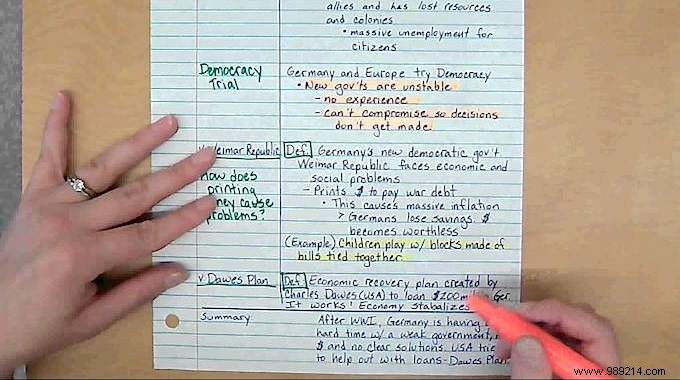
Knowing how to take notes correctly in class is essential for retaining important information .
Why ? Because 9 hours after a lesson, we have already forgotten 60% of our notes.
Even if the miracle solution doesn't exist, there are 3 proven methods for taking good notes.
So to better record the info, test them without delay:

To print this practical guide in PDF, click here.
This method consists of organizing the ideas on the page well, respecting precise spacing.
This is the ideal method when:
- The outline of a presentation (slide type) has already been provided.
- You want to take notes from written materials.
The advantage: Main points can easily be turned into question during proofreading.
The downside: We do not see the relations or connections between the arguments.
This method relies on a notes page division system that was developed by dr. Walter Paulk of Cornell University in the United States.
When you review your notes:
• Transform the key words/ideas in the clues column into questions.
• Hide your notes.
• Try to answer the questions from memory.
This is the ideal method for:
- Easily produce and memorize the important ideas of a lesson.
- Prepare and revise for exams.
The advantage :The printable Cornell grade sheet is available online by clicking right here.
The downside :This method requires additional time to complete the "summary" column.
Ideas are visually connected in a non-linear way.
This is the ideal method for:
- Courses with dense content.
The advantage: The notes can be refined afterwards by recreating the cartography via a program like draw.io for example.
The downside :Note taking can be tricky if you are unsure of the lesson structure beforehand.
Before class:
- Read the relevant chapters of the book and/or view the slides. You will become comfortable with the topic and you will be able to identify key ideas more easily.
During the course:
- In an amphitheater, sit as far forward as possible.
- Pay attention to clues on important points:repetitions, changes in the lecturer's tone of voice.
- Do not write everything and always rephrase what you hear.
- Use shorthand, abbreviations and symbols.
After class:
- Proofread your notes within 24 hours.
- Identify any comprehension problems, and consult your teacher, classmates or course book for help.